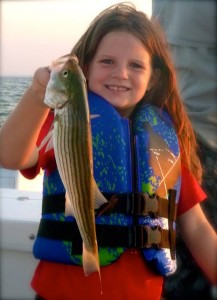 I want to take a few minutes to update everyone on the continuing bizarre actions of The Maryland Department of Natural Resources (DNR) toward striped bass. In my last entry, I reported that, despite pending actions to reduce striped bass harvest by the Atlantic States Marine Fisheries Commission (ASMFC), Chesapeake Bay fisheries managers – including those from the Potomac River and Virginia – have announced plans to increase harvest. They justify this with statistics showing more 18-inch fish in the Bay as a result of the 2011 spawning year class. This flies in the face of pleas from anglers in Maryland and all up and down the Atlantic Seaboard for additional conservation of striped bass. Simply put, at a time when anglers think we should be cutting back on a species in trouble, Chesapeake managers want to kill more.
I want to take a few minutes to update everyone on the continuing bizarre actions of The Maryland Department of Natural Resources (DNR) toward striped bass. In my last entry, I reported that, despite pending actions to reduce striped bass harvest by the Atlantic States Marine Fisheries Commission (ASMFC), Chesapeake Bay fisheries managers – including those from the Potomac River and Virginia – have announced plans to increase harvest. They justify this with statistics showing more 18-inch fish in the Bay as a result of the 2011 spawning year class. This flies in the face of pleas from anglers in Maryland and all up and down the Atlantic Seaboard for additional conservation of striped bass. Simply put, at a time when anglers think we should be cutting back on a species in trouble, Chesapeake managers want to kill more.
The people of Maryland deserve more from the agencies who are charged with protecting their fish. Today, leaders from the Maryland Coastal Conservation Association (CCA) met with Fisheries Director Mr. Thomas O’Connell and others from DNR in an attempt to persuade them to reduce harvest, not increase it. I am not optimistic. There is even talk of reducing conservation buffers in subsequent years so Chesapeake states can continue to harvest at present levels. In other words, they might try to get around ASMFC mandated cuts in 2015 by changing their accounting methods. We all understand the science behind the decision, but just because there are more young fish in the Bay from one successful spawning year doesn’t mean we should kill more, especially when stocks are threatened. I am including a letter CCA delivered below. Read More!
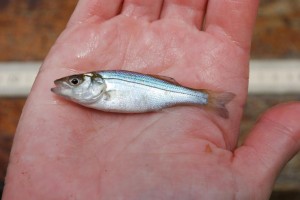 “Let’s kill as many as we can before we have to save them.” That seems to be the attitude of the Maryland Department of Natural Resources. Tuesday, just before closing for a five day Thanksgiving weekend, DNR fisheries dropped a turkey on recreational striped bass anglers by announcing a 14% increase in harvest in the Chesapeake Bay. At a time when striper stocks are steeply declining and states up and down the Atlantic seaboard face impending cuts mandated by the Atlantic States Marine Fisheries Commission (ASMFC), Maryland & Virginia are grabbing more fish. Here’s a link to the press release and a quote:
“Let’s kill as many as we can before we have to save them.” That seems to be the attitude of the Maryland Department of Natural Resources. Tuesday, just before closing for a five day Thanksgiving weekend, DNR fisheries dropped a turkey on recreational striped bass anglers by announcing a 14% increase in harvest in the Chesapeake Bay. At a time when striper stocks are steeply declining and states up and down the Atlantic seaboard face impending cuts mandated by the Atlantic States Marine Fisheries Commission (ASMFC), Maryland & Virginia are grabbing more fish. Here’s a link to the press release and a quote:
Determination of the Available 2014 Chesapeake Bay Commercial Striped Bass Quota
For 2014, it was decided that fishermen could safely harvest 8,652,528 pounds of Striped Bass – without detriment to the Bay population. The previous year’s quota was 7,589,937 pounds and for the first time in many years the quota has been increased in the Bay. This increase of approximately 14% is attributed to a large number of fish from the 2011 year class (fish that hatch and enter into the population in a given year) which are just now reaching the legal minimum size of 18 inches.
I hope you find that as unbelievable as I do. I’ve tried to keep fisheries politics out of this blog lately because I want to concentrate on the fun parts of our sport, but when something this egregious comes out, I think it’s important to spread the news and let our fisheries managers know just how pissed off recreational anglers can be. Read More!
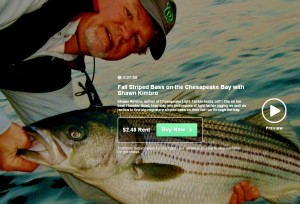 I mentioned in my last entry that I am working on a series of instructional videos with Jeff Little. Jeff is the owner of Blue Ridge Kayak Fishing and has produced four successful DVDs on kayak fishing and seasonal tactics for river smallmouth bass. In 2007 he authored My Life in a Kayak: In Pursuit of Trophy Smallmouth. He has numerous appearances in regional and national publications such as Bassmaster Magazine, North American Fisherman, Bassin’, Kayak Angler, and others. Besides Jeff’s obvious media and marketing skills, I am finding him to be a darn good fisherman.
I mentioned in my last entry that I am working on a series of instructional videos with Jeff Little. Jeff is the owner of Blue Ridge Kayak Fishing and has produced four successful DVDs on kayak fishing and seasonal tactics for river smallmouth bass. In 2007 he authored My Life in a Kayak: In Pursuit of Trophy Smallmouth. He has numerous appearances in regional and national publications such as Bassmaster Magazine, North American Fisherman, Bassin’, Kayak Angler, and others. Besides Jeff’s obvious media and marketing skills, I am finding him to be a darn good fisherman.
I mentioned last week how a good fisherman can be successful almost anywhere on any species when they learn to recognize patterns. There’s obviously more to it than that, but the key word in that sentence is learn. Light tackle casting for striped bass and other species on the Chesapeake Bay isn’t rocket science, but there is still a significant learning curve if you want to be consistently successful. Read More!
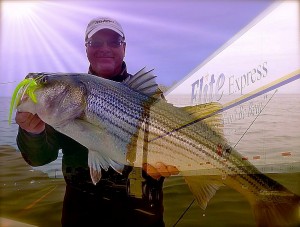 Tell someone where to catch a Chesapeake Bay striped bass and you may help them for a day, but teach them how to identify specific seasonal patterns, and you’ve put them on the express route to becoming an elite fisherman. The fall migratory run is on. This is the time of year when the learning curve drops significantly and stripers feed voraciously. They aren’t too picky about the kind of baits they’ll take and they aren’t as choosy about lure presentation. It’s a great time to learn how to cast lures for big fish. It’s also the time when I step up on my “think patterns, not places” soapbox. Ask any accomplished angler their secret to repeated success and they’ll tell you it’s the ability to identify specific feeding patterns. I believe that you can drop a good fisherman into any body of water in the world and he’ll catch fish as long as you give him enough time to recognize prevailing patterns. Pattern recognition is especially important on the Chesapeake where conditions change quickly. Fortunately, fish are creatures of habit and we can identify predictable characteristics in their behavior.
Tell someone where to catch a Chesapeake Bay striped bass and you may help them for a day, but teach them how to identify specific seasonal patterns, and you’ve put them on the express route to becoming an elite fisherman. The fall migratory run is on. This is the time of year when the learning curve drops significantly and stripers feed voraciously. They aren’t too picky about the kind of baits they’ll take and they aren’t as choosy about lure presentation. It’s a great time to learn how to cast lures for big fish. It’s also the time when I step up on my “think patterns, not places” soapbox. Ask any accomplished angler their secret to repeated success and they’ll tell you it’s the ability to identify specific feeding patterns. I believe that you can drop a good fisherman into any body of water in the world and he’ll catch fish as long as you give him enough time to recognize prevailing patterns. Pattern recognition is especially important on the Chesapeake where conditions change quickly. Fortunately, fish are creatures of habit and we can identify predictable characteristics in their behavior.
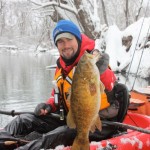
I fished this past Saturday with a new fishing buddy, Jeff Little. You may have heard of Jeff because he’s well-known in the kayak fishing world for his instructional DVDs and videos about smallmouth fishing. Fortunately for Chesapeake Bay fishermen, he’s been bit by the striper bug. I’ve teamed up with him to produce some videos that illustrate my most successful techniques. Stay tuned because we’ll soon be posting one we shot Saturday about striper fishing in the fall on the Chesapeake Bay. We’ll launch a short preview first. If you like it, you can watch the action-packed 30-minute version for just $2.49. Read More!
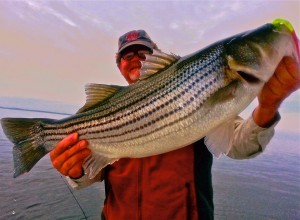 One of the more frequently asked questions I get whether by email or in person is, “How can I consistently catch bigger fish?” I’ve written about moving your game up to the next level before, but since we now have some migratory stripers in the Maryland part of the Chesapeake Bay, it’s worthwhile to address it again. The learning curve gets a little shorter in the fall and it’s a great chance to sharpen your skills. I’ll start by saying there are no hard and fast rules for catching stripers. Over my years of casting for them I feel like I’ve honed my techniques so that, on any given day, I have an edge for catching a trophy. That said, I’m still frequently surprised when a huge striper is caught by some completely different method than I’ve seen before. One thing is for sure, things change. There’s no substitute for experience but anglers who aren’t willing to stay on top of the latest innovations and newest techniques are certain to be left behind. Read More!
One of the more frequently asked questions I get whether by email or in person is, “How can I consistently catch bigger fish?” I’ve written about moving your game up to the next level before, but since we now have some migratory stripers in the Maryland part of the Chesapeake Bay, it’s worthwhile to address it again. The learning curve gets a little shorter in the fall and it’s a great chance to sharpen your skills. I’ll start by saying there are no hard and fast rules for catching stripers. Over my years of casting for them I feel like I’ve honed my techniques so that, on any given day, I have an edge for catching a trophy. That said, I’m still frequently surprised when a huge striper is caught by some completely different method than I’ve seen before. One thing is for sure, things change. There’s no substitute for experience but anglers who aren’t willing to stay on top of the latest innovations and newest techniques are certain to be left behind. Read More!
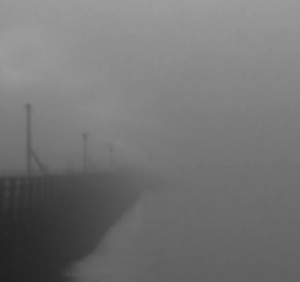 I awoke that rainy morning to the rumbles of thunder. From my upstairs bedroom on Kent Island, I could hear the long low blasts of foghorns as big ships passed beneath the Chesapeake Bay Bridge. They sounded eerily closer than usual this morning at 4:00 AM. I listened to the ships until it was apparent that I wouldn’t go back to sleep. I haven’t been fishing as much as I like to. My only opportunities have been in the early mornings before work, and often in less than optimum conditions.
I awoke that rainy morning to the rumbles of thunder. From my upstairs bedroom on Kent Island, I could hear the long low blasts of foghorns as big ships passed beneath the Chesapeake Bay Bridge. They sounded eerily closer than usual this morning at 4:00 AM. I listened to the ships until it was apparent that I wouldn’t go back to sleep. I haven’t been fishing as much as I like to. My only opportunities have been in the early mornings before work, and often in less than optimum conditions.
This morning, despite the dreadful weather, I decided to make the best of the time I had available. I call my boat Thunder Road. The name is homage to the 1950’s song and movie by Robert Mitchum, but also because the Eastern Shore-built Judge 27CC is well suited to difficult weather conditions just like this mornings. I grabbed my phone, put on some rain gear, and backed the boat out of the driveway.
It was pitch black when I arrived at the Matapeake boat ramp. Oddly, the lights were out on the pier. It wasn’t windy, and a dense fog had set in. I launched into the dark water and idled slowly toward the mouth of the inlet without the lights of my sonar or GPS so I wouldn’t destroy what little night vision I had. The fog was so thick I could barely see past the front of my boat. I wiped my glasses and breathed a sigh of relief as I slipped between the end of the wooden pilings and the rock jetty. I was surprised to look up and see the shadow of a lone figure standing at the end of the pier. Another hardcore fisherman I thought, but then I noticed he didn’t have a fishing rod. My wave wasn’t returned as I continued out into the murky open waters of the Chesapeake. There was a cold chill in the air, so I pulled up my hood and swung the bow north into a strong outgoing tide.


